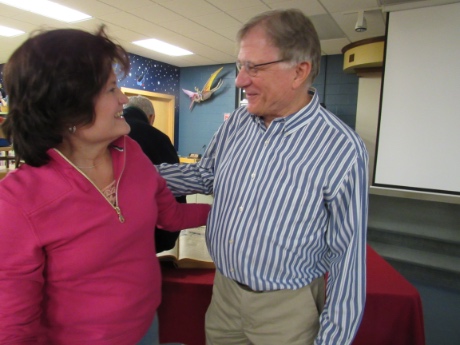
Pembroke High School Social Studies teacher Greg Kinal gets a hug from a former student, Terry Hendry, of Oakfield, after his presentation on D-Day for the Medina Historical Society.
Having taught Social Studies at Pembroke High School or nearly five decades, it’s not surprising Greg Kinal has an above-average interest in World War II, especially D-Day.
Kinal, who will celebrate 50 years as a Pembroke teacher next year, gives about 75 speeches a year and does 40 presentations for historical societies.
“Most of my speeches are to adult groups and I try to pick topics each group would like,” Kinal said. “I have always been infatuated with the events of D-Day and it is a favorite of audiences.”
His interest in D-Day is also fueled by his family’s ties to World War II.
His father was a top turret gunner on a B-25, serving in North Africa and the Italian Campaign. He also had an uncle, Dr. Murl Kinal, who was a neurosurgeon and served as a medic at Normandy. Another uncle, George Frank Schultz, served aboard the USS Quincy and was the first ship to fire on occupied Normandy.
A few years ago, the family arranged for Kinal to take a ride in a B-25 Mitchell bomber at Hagerstown, Md., to celebrate his 70th birthday, but the weather turned sour and the flight was canceled.
Now they have made arrangements for the whole family to go back to Hagerstown this summer for the airplane ride in a B-25.
Kinal gave his talk on D-Day for a recent meeting of the Medina Historical Society at Lee Whedon Memorial Library in Medina. The presentation was timely as the world commemorates the 75th anniversary of the attack on Normandy this Thursday, June 6.
He started his talk by explaining prior to World War II, America had an army of 334,000. By 1943, the number had grown to 12 million, and was soon at 16 million.
In 1939, the United States made fewer than 1,000 planes a year. By the end of 1943, they were building 8,000 a month.
By comparison, in Ypsilanti, Mich., the average car built by Ford Motor Company had 15,000 parts. A B-24 Liberator had more than 1,550,000 parts. When Ford started making B-24s, they were turning out one every 63 minutes.
Prior to the Allied invasion of Normandy, the United States set up a fake base in England across from Calais, with fake tanks.
“They wanted the Germans to think we were going to come across the Channel to Calais, and they bought it,” Kinal said. “Instead, our troops were in Southern England.”
The battle for Normandy was called Operation Overlord, and the D-Day beach landings on its coast was code-named Operation Neptune. The invasion was originally scheduled for June 5, 1944, but the weather turned sour.
They finally got a break, and at 9:45 p.m. on June 5. General Dwight D. Eisenhower issued the command, “OK, let’s go” and 800 Allied planes left England with 20,000 paratroopers for the June 6 invasion, which was a Tuesday.
It was the largest seaborne invasion in history.
The 5,000 ships carried 155,000 troops on the first wave. The average age was 22.
The Germans used machine guns which fired 125 bullets per second, Kinal said.
Five hours later, the Americans were in control of Omaha Beach and by night the Allies were 10 miles into Normandy.
Next came the assault on Utah Beach, and when night came, the Americans had taken all five beaches of Normandy, Kinal said.
During the attack, 300 planes bombed the coast and 13,000 paratroopers jumped into battle. There were 800 transport planes and the ships carried 448,000 tons of ammunition.
The Americans thought they were doing the soldiers a big favor by feeding them a big breakfast of steak, eggs, pork chops and potatoes, not realizing they would mostly all become seasick.
The fighting left 4,414 dead on the beaches, of which 2,499 were Americans. German casualties, however, were estimated at 10,000, Kinal said.
Today, 1,700 Americans are still missing.
“This operation was not planned with any alternatives,” Kinal quoted General Eisenhower. “This operation was planned as a victory. That’s the way it’s going to be.
"We’re going down there and we’re throwing everything we have into it and we’re going to make it a success.”
Kinal lives in Elma where he says they have a veteran who was on the first wave of the attack on Omaha Beach. Each year, the fire company has a gun raffle in Elma, and this veteran is asked to pull the first ticket.
Kinal said he was just asked to give his D-Day talk in Bennington and many people showed up to hear him. There were even six or eight people who had fathers who landed in Normandy on D-Day.
Photo by Virginia Kropf.
